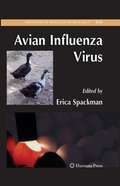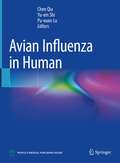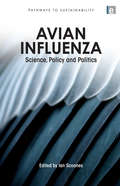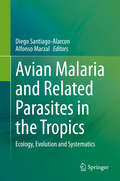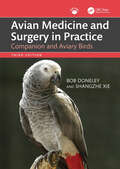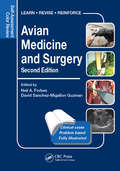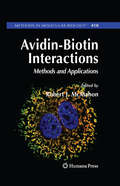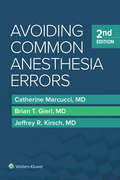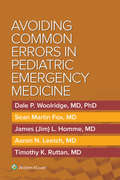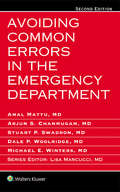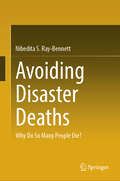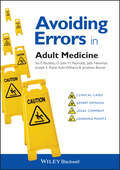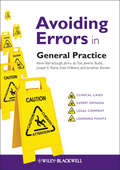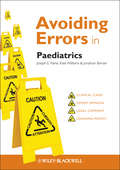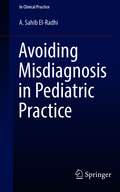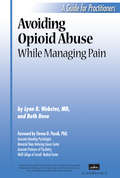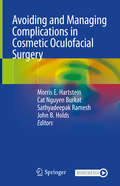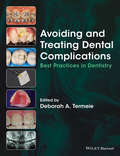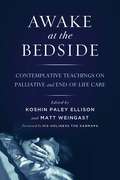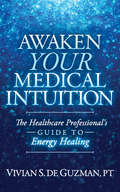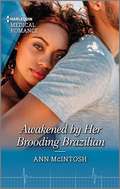- Table View
- List View
Avian Gut Function in Health and Disease
by G. C. PerryThis book focuses on the current interest of the phasing out of antibiotic use in poultry and covers in-depth interactions between the bird, its diet and potential pathogens.
Avian Influenza Virus (Methods in Molecular Biology #436)
by Erica SpackmanWith the growing global fear of a major pandemic, avian influenza (AI) virus research has greatly increased in importance. In Avian Influenza Virus, an expert team of researchers and diagnosticians examine the fundamental, yet essential, virological methods for AI virus research and diagnostics as well as some of the newest molecular procedures currently used for basic and applied research. They present exciting, cutting-edge new methods that focus both on studying the virus itself and on work with avian hosts, an area greatly lacking in research.
Avian Influenza in Human
by Pu-Xuan Lu Chen Qiu Yu-Xin ShiSome avian influenza viruses can infect humans, cause disease, and even result in deaths. This book comprehensively and systematically presents the theory, diagnosis and clinical treatment of typical avian influenza viruses in human. The first chapters introduce the ethiology, epidemiology, clinical diagnosis and treatment of human avian influenza and complications. The following chapters include overview, extensive images, differential diagnosis and clinical cases of H7N9, H5N1, H5N6, H10N8, H9N2 and H7N4 avian influenza. Written by practitioners directly involved in the prevention and clinical treatment of human avian influenza, it will be an invaluable aid for practitioners in centers for infectious disease control and prevention, hospitals, and academic institutions to improve prevention, diagnosis and treatment of avian influenza in human.
Avian Influenza: "Science, Policy and Politics" (Pathways To Sustainability Ser.)
by Ian ScoonesOver the past decade, substantial resources have been spent on tackling avian influenza and building a global capacity for a pandemic response. The catastrophic costs of the 1918 influenza pandemic are well documented, and the swine flu pandemic of 2009-10 has raised the alarm yet again. Across the world, surveillance systems have been upgraded, stockpiles of antiviral drugs and influenza vaccines have been created, veterinary and public health systems have been improved and poultry production and marketing has been dramatically restructured. What are the lessons from this experience? And what does this suggest for the future? This book explores how virus genetics, ecology and epidemiology intersect with economic, political and policy processes in a variety of places - from Bangkok to Washington, to Jakarta, Cairo, Rome and London. It focuses on the interaction of the international and national responses - and in particular the experiences of Cambodia, Vietnam, Indonesia and Thailand. It asks how effective is the disease surveillance and response system - can it respond to a new pandemic threat? The comparative analysis reveals the challenges and limitations of a technocratic, centralised response, and the need to take seriously local contexts. Drawing from these experiences, the book concludes with a discussion of future prospects and challenges, examining in particular what a 'One World, One Health' approach - where approaches to animal, human and ecosystem health are integrated - would look like in practice. Published in association with the Economic and Social Research Council (ESRC)
Avian Malaria Parasites and other Haemosporidia
by Gediminas ValkiunasWhen studying the effects of parasites on natural populations, the avian haematozoa fulfills many of the specifications of an ideal model. Featuring a multitude of tables and illustrations, Avian Malaria Parasites and Other Haemosporidia summarizes more than a century of research on bird haemosporidians. For a long time, bird blood parasites served as important models in studying human diseases. Although now largely replaced, the wealth of data and research remain. With chapters addressing life cycles and morphology, pathogenicity, ultrastructure, geographical distribution, and illustrated keys to all known species of the parasites, this book is a masterful assessment of the biology of bird haemosporidian parasites.
Avian Malaria and Related Parasites in the Tropics: Ecology, Evolution and Systematics
by Diego Santiago-Alarcon Alfonso MarzalThe Tropics are home to the greatest biodiversity in the world, but tropical species are at risk due to anthropogenic activities, mainly land use change, habitat loss, invasive species, and pathogens. Over the past 20 years, the avian malaria and related parasites (Order: Haemosporida) systems have received increased attention in the tropical regions from a diverse array of research perspectives. However, to date no attempts have been made to synthesize the available information and to propose new lines of research. This book provides such a synthesis by not only focusing on the antagonistic interactions, but also by providing conceptual chapters on topics going from avian haemosporidians life cycles and study techniques, to chapters addressing current concepts on ecology and evolution. For example, a chapter synthesizing basic biogeography and ecological niche model concepts is presented, followed by one on the island biogeography of avian haemosporidians. Accordingly, researchers and professionals interested in these antagonistic interaction systems will find both an overview of the field with special emphasis on the tropics, and access to the necessary conceptual framework for various topics in ecology, evolution and systematics. Given its conceptual perspective, the book will appeal not only to readers interested in avian haemosporidians, but also to those more generally interested in the ecology, evolution and systematics of host-parasite interactions.
Avian Medicine and Surgery in Practice: Companion and Aviary Birds
by Bob Doneley Shangzhe XieThis book is an invaluable quick reference resource for clinicians and a useful study guide for veterinary students and residents.This practical and beautifully illustrated book takes you on a walk through avian medicine, beginning with the basics, such as common species, husbandry, nutrition, and grooming, before moving on to the more clinical-focused material, such as how to perform a physical examination, collect samples and interpret diagnostic tests, take good quality radiographs and then interpret them, and how to support a sick bird while in hospital.It then moves into the disorders affecting the different organs and body systems. Each chapter begins with a description of clinical anatomy and physiology before going on to explore the disorders associated with the effects of disease or trauma. The book also addresses behavioural problems, incubation of eggs, paediatrics, anaesthesia, and surgery.For this edition, Bob Doneley is joined by avian, zoo/wildlife and exotic pet veterinarian Shangzhe Xie. Together they have thoroughly updated the book by incorporating the latest research and covering a larger range of avian species. Building on the practical aspects that make this book stand out from other resources, they have added step-by-step pictorial guides to common procedures and surgeries, as well as videos for longer, more complicated ones. Avian Medicine and Surgery in Practice will therefore allow the practitioner to immediately help the patient at hand, whether to prescribe a medication or perform a life-saving surgery.
Avian Medicine and Surgery in Practice: Companion and Aviary Birds, Second Edition (Manson Ser.)
by Bob DoneleyAvian Medicine and Surgery in Practice is an invaluable quick reference resource for clinicians and a useful study guide for veterinary students. In this practical and beautifully illustrated book, early chapters cover physical examination, advice on interpreting diagnostic tests, and avian anatomy and physiology. Disorders affecting the different body regions and systems make up the majority of the book from the external—skin, feathers, eyes, legs and feet—to the internal including the gastrointestinal tract and the cardiovascular system. Further aspects of avian medicine discussed in the book include behavioural problems, incubation of eggs, paediatrics and surgery. Written by an expert with more than 30 years of clinical experience in avian medicine, the new edition is thoroughly revised with updated diseases, new and expanded clinical techniques, and over 100 new color illustrations. It also adds four important new chapters: Husbandry, Grooming and Nutrition, Diagnostic Imaging, Endoscopy, and Oncology as well as new sections on cardiovascular anatomy and neuroanatomy.
Avian Medicine and Surgery: Self-Assessment Color Review, Second Edition (Veterinary Self-Assessment Color Review Series)
by Neil Forbes David Sanchez-Migallon GuzmanThis completely revamped second edition of Avian Medicine and Surgery includes over 260 all-new colour illustrated cases, with questions and answers fully exploring a breadth of diseases and disorders. Avian patients are a routine part of the veterinary case load and are being seen by many clinicians across the world. This book provides a unique quick reference for clinicians and a useful self-test for students by offering comprehensive, clinically-oriented information that can be quickly accessed, easily understood and applied. With contributions from leading international authorities with diverse fields of expertise, the book covers a wide range of disciplines, organ systems and species. The cases are presented in a random order, just as they would appear in daily practice, challenging the reader to address real clinical situation and offering, where possible, a comprehensive solution.
Avidin-Biotin Interactions: Methods and Applications (Methods in Molecular Biology #418)
by Robert J. McmahonThis book is specifically about the application of the extremely powerful interaction between the protein avidin or its homologues and the vitamin biotin and some of its homologues. With excellent descriptions of laboratory protocols written by expert researchers, this volume is equally perfect for the student or the professional laboratory scientist.
Avoiding Common Anesthesia Error (A\lippincott Williams And Wilkins Handbook Ser.)
by Jeffrey R. Kirsch Catherine Marcucci GierlThe full-color Avoiding Common Anesthesia Errors, significantly updated for this second edition, combines patient safety information and evidence-based guidance for over 300 commonly encountered clinical situations. With a format that suggests conversations between an attending and a trainee, the book helps you identify potential problems and develop a treatment plan to minimize the problem. Brief, easy-to-read chapters cover basic and advanced topics and help you digest information in minutes!
Avoiding Common Errors in Pediatric Emergency Medicine
by Sean Fox Jim Homme Aaron Leetch Tim RuttanConversational and easy to read, Avoiding Common Errors in Pediatric Emergency Medicine discusses 198 errors commonly made in the practice of pediatric emergency medicine and gives practical, easy-to-remember tips for avoiding these pitfalls. This unique manual offers brief, approachable, evidence-based chapters suitable for reading immediately before the start of a rotation, for quick reference on call, or daily for personal assessment and review.
Avoiding Common Errors in the Emergency Department
by Amal Mattu Michael Winters Arjun S. Chanmugam Stuart P. Swadron Dale WoolridgeIn a conversational, easy-to-read style, Avoiding Common Errors in the Emergency Department, 2nd Edition, discusses 365 errors commonly made in the practice of emergency medicine and gives practical, easy-to-remember tips for avoiding these pitfalls. Chapters are brief, approachable, and evidence-based, suitable for reading immediately before the start of a rotation, used for quick reference on call, or read daily over the course of one year for personal assessment and review.
Avoiding Disaster Deaths: Why Do So Many People Die?
by Nibedita S. Ray-BennettThis book introduces a pathbreaking approach called &‘Avoidable Disaster Deaths&’ (ADD) to reduce disaster deaths. Disaster deaths are the direct and indirect impact of hazards. The &‘Sendai Framework for Disaster Risk Reduction&’ has urged the United Nations Member States to reduce disaster deaths or mortality by 2030. Reducing the number of disaster deaths has become a useful marker for improving disaster risk management. Equally important is knowing how people die, who dies, why they die, and which disaster deaths are &‘avoidable&’ and &‘unavoidable&’. Disaster risk reduction specialists have not fully examined these questions. Built from disaster risk reduction, public health, epidemiology, human geography, risk and crisis management studies, the ADD approach disaggregates disaster deaths into avoidable and unavoidable. Avoidable disaster deaths are preventable, amenable and governance-related. Unavoidable deaths are those that occur annually due to natural causes or poverty-related diseases. In a disaster climate, the emphasis should be on reducing avoidable disaster deaths in a resource-constrained context. Using the context of COVID-19 and the economic lockdown in India, the analytical advantage of this approach is explored. Doing so, the book brings forth human stories whose lives were cut short and introduces novel matrices and dynamic strategies to ascertain the &‘cause and circumstances&’ of avoidable disaster deaths to develop the capacity of disaster and health responders. The book is suitable for students, academics, policy-makers and practitioners interested in disaster risk reduction, human rights, risk and crisis management, environmental science, human geography, Sustainable Development and Sendai Goals. The book is also suitable for passionate citizens who want to capture the number, causes and circumstances of avoidable disaster deaths and take positive action to save lives in their communities. Professor Nibedita S. Ray-Bennett ably presents a novel &‘avoidable disaster deaths&’ approach to disaster risk reduction and management by presenting cogent arguments rooted in solid theory and up to date literature reviews, complemented by a wealth of data and analysis from the Indian Covid 19 experience. The book includes a range of tables and diagrams that crystallise approaches and practices useful for policy makers and practitioners alike. The book is highly informed, well written, accessible, practical and useful, with an optimal mix of strong, well-tested academic theory, and important recommendations that demand serious consideration by all involved and interested in disasters. A spur to action and inspiration. (Professor Michael Petterson, School of Social Sciences, Auckland University of Technology, New Zealand)
Avoiding Errors in Adult Medicine
by Kate Williams Jonathan Bonser Joseph E. Raine Sally Newman D. John Reynolds Ian RecklessSome of the most important and best lessons in a doctor's career are learnt from mistakes. However, an awareness of the common causes of medical errors and developing positive behaviours can reduce the risk of mistakes and litigation.Written for junior medical staff and consultants, and unlike any other clinical management title available, Avoiding Errors in Adult Medicine identifies and explains the most common errors likely to occur in an adult medicine setting - so that you won't make them. The first section in this brand new guide discusses the causes of errors in adult medicine. The second and largest section consists of case scenarios and includes expert and legal comment as well as clinical teaching points and strategies to help you engage in safer practice throughout your career. The final section discusses how to deal with complaints and the subsequent potential medico-legal consequences, helping to reduce your anxiety when dealing with the consequences of an error.Invaluable during the Foundation Years, Specialty Training and for Consultants, Avoiding Errors in Adult Medicine is the perfect guide to help tackle the professional and emotional challenges of life as a physician.
Avoiding Errors in General Practice
by Kate Williams Jonathan Bonser Joseph E. Raine Jenny Du Toit Jeremy Budd Kevin BarracloughSome of the most important and best lessons in a doctor's career are learnt from mistakes. However, an awareness of the common causes of medical errors and developing positive behaviours can reduce the risk of mistakes and litigation.Written for Foundation Year doctors, trainees and general practitioners, and unlike any other clinical management title available, Avoiding Errors in General Practice identifies and explains the most common errors likely to occur in an outpatient setting - so that you won't make them. The first section in this brand new guide discusses the causes of errors in general practice. The second and largest section consists of case scenarios and includes expert and legal comment as well as clinical teaching points and strategies to help you engage in safer practice throughout your career. The final section discusses how to deal with complaints and the subsequent potential medico-legal consequences, helping to reduce your anxiety when dealing with the consequences of an error.Invaluable during the Foundation Years, Specialty Training and for Consultants, Avoiding Errors in General Practice is the perfect guide to help tackle the professional and emotional challenges of life as a GP.
Avoiding Errors in Paediatrics
by Kate Williams Jonathan Bonser Joseph E. RaineSome of the most important and best lessons in a doctor's career are learnt from mistakes. However, an awareness of the common causes of medical errors and developing positive behaviours can reduce the risk of mistakes and litigation.Written for junior paediatric staff and consultants, and unlike any other paediatric clinical management title available, Avoiding Errors in Paediatrics identifies and explains the most common errors likely to occur in a paediatric setting - so that you won't make them. The first section in this brand new guide discusses the causes of errors in paediatrics. The second and largest section consists of case scenarios and includes expert and legal comment as well as clinical teaching points and strategies to help you engage in safer practice throughout your career. The final section discusses how to deal with complaints and the subsequent potential medico-legal consequences, helping to reduce your anxiety when dealing with the consequences of an error.Invaluable during the Foundation Years, Specialty Training and for Consultants, Avoiding Errors in Paediatrics is the perfect guide to help tackle the professional and emotional challenges of life as a paediatrician.
Avoiding Misdiagnosis in Pediatric Practice (In Clinical Practice)
by A. Sahib El-RadhiThis book discusses the most common symptoms in pediatrics. It is based on best available scientific evidence and up-to-date information. The book also discusses a range of common conditions associated with bacterial and viral infections of the oro-nasal, eye, chest, abdominal and genito-urinary regions. The book helps the clinician to distinguish symptoms andsigns of pediatric diseases to avoid diagnostic errors. Each chapter starts with a list of core messages, and includes tables and figures to focus on the subjects under discussion. The whole text is written in reader-friendly manner. The book is of interest to general pediatricians and doctors in primary care. It is also of interest to students, nurses and other professionals who look after children.
Avoiding Opioid Abuse While Managing Pain
by Beth Dove Lynn R WebsterThis book was written to help all interested parties (eg, clinicians who treat pain, drug and medical-practice regulators, law-enforcement authorities and pharmacists) to sort out the clinical, regulatory, and ethical issues associated with the prescribing of opioid analgesics and to reduce the risk of medication misuse, abuse, and diversion.
Avoiding and Managing Complications in Cosmetic Oculofacial Surgery
by Morris E. Hartstein John B. Holds Cat Nguyen Burkat Sathyadeepak RameshThis unique book focuses solely on educating aesthetic practitioners on how to best avoid complications. Should complications occur, the text, alongside high quality images and supplementary video, details how best to deal with them in terms of the patient’s findings, individual anatomy, and emotional state. Avoiding and Managing Complications in Cosmetic Oculofacial Surgery is divided into four sections for ease of use: meticulous preoperative planning, including proper patient selection; potential intraoperative complications and their management; postoperative complication-specific management such as lower eyelid retraction; and special topics including scar management, crease asymmetry, and complications of other periocular surgery and non-surgical procedures.Drawing on the vast experiences of the volume editors as oculofacial surgeons as well as the varied experiences of the contributors from facial plastics and dermatology this book provides a useful and vital tool for aesthetic practitioners in any specialty.
Avoiding and Treating Dental Complications: Best Practices in Dentistry
by Deborah TermeieComplications from dental procedures are inevitable and encountered by all dental professionals. Avoiding and Treating Dental Complications: Best Practices in Dentistry is designed to address proper management of these situations in everyday practice. Covers a range of dental issues and complications found in daily practice Written by experts in each specialty Features tables and charts for quick information Includes clinical photographs and radiographs
Awake at the Bedside: Contemplative Teachings on Palliative and End-of-Life Care
by Koshin Paley Ellison His Holiness the Karmapa Matt WeingastThis book isn't about dying. It's about life and what life has to teach us. It's about caring and what giving care really means. In Awake at the Bedside, pioneers of palliative and end-of-life care as well as doctors, chaplains, caregivers and even poets offer wisdom that will challenge, uplift, comfort--and change the way we think about death. Equal parts instruction manual and spiritual testimony, it includes specific instructions and personal accounts to inspire, counsel, and teach. An indispensable resource for anyone involved in hospice work or caregiving of any kind. Contributors include Anyen Rinpoche, Coleman Barks, Craig D. Blinderman, Bhikkhu Bodhi, Joshua Bright, Ira Byock, Robert Chodo Campbell, Rafael Campo, Ajahn Chah, Ram Dass, Kristen DeLeo, Issan Dorsey, Mark Doty, Norman Fischer, Nick Flynn, Gil Fronsdal, Joseph Goldstein, Shodo Harada Roshi, Tony Hoagland, Marie Howe, Fernando Kawai, Michael Kearney, Elisabeth Kubler-Ross, Stanley Kunitz, Stephen and Ondrea Levine, Judy Lief, Betsy MacGregor, Diane E. Meier, W. S. Merwin, Naomi Shihab Nye, Frank Ostaseski, Rachel Naomi Remen, Larry Rosenberg, Rumi, Cicely Saunders, Senryu, Jason Shinder, Derek Walcott, Radhule B. Weininger.
Awaken Your Medical Intuition: The Healthcare Professional’s Guide to Energy Healing
by Vivian S. De GuzmanHolistic physical therapist, human MRI, and master healer Vivian S. De Guzman, PT has guided thousands toward honing their intuitive gifts for decades. Now, she writes Awaken Your Medical Intuition to help healthcare professionals harness their power so that they can make the biggest impact possible with their life and soul’s purpose. Within Awaken Your Medical Intuition, Vivian shares with healthcare professionals:The truth about why they keep on avoiding their gifts as a medical intuitiveThe reason most doctors, healthcare professionals, empaths, and healers fail in their business The difference between people who are ready to acknowledge their medical intuitive gifts and those who are not Factors contributing to their energetic imbalances and health problems. How to align all of them to bring wealth, health, and great relationships! Practical, simple, and highly-effective tools to open and enhance their intuitive skills
Awakened by Her Brooding Brazilian: A Summer In S�o Paulo (A Summer in São Paulo #1)
by Ann McIntoshThe playboy surgeon—and the shy workaholic!Dr. Krysta Simpson feels a connection with brooding Francisco Carvalho immediately. The ex-model turned surgeon is nothing like the cruel rumors would have her believe. And if she’s determined to use this temporary placement in stunning S‹o Paulo to reset her priorities, she’s running out of time…leaving one important question: Will Francisco show her the pleasure she’s never experienced?An A Summer in São Paulo novelA Summer in São Paulo trilogyBook 1 — Awakened by Her Brooding BrazilianBook 2 — Falling for the Single Dad Surgeon by Charlotte Hawkes Look out for the next book, coming soon:Book 3 — One Hot Night with Dr. Cardoza by Tina Beckett“What a charming, fast-paced, entertaining read Ms. McIntosh has delivered in this opposite attract medical romance where the main characters have interesting back stories…the dialogue drew me in right from the beginning and had me loving the building chemistry and romance….”—Harlequin Junkie on The Nurse’s Christmas Temptation“Author Ann McIntosh brought this story with emotions and medical drama. A reader would stay glued to the book till the last page to find what happens next…. Highly recommended for all readers of medical romance.”—Goodreads on The Surgeon’s One Night to Forever
Awakening His Shy Vet: A Stolen Kiss With The Midwife / Awakening His Shy Vet (Mills And Boon Medical Ser.)
by Shelley RiversThey’re looking for a fresh start……with each other?After the tragic death of his wife, horse trainer Kern MacKinley shut himself off from the world—and love. Until the arrival of vet Ruby Day… Ruby may be reserved, but she has an unrivaled way with animals. Soon Kern discovers it’s not just her patients that Ruby has the ability to heal. But once he lets Ruby in, there’s no going back… Can he heal her, too?From Harlequin Medical: Life and love in the world of modern medicine.

